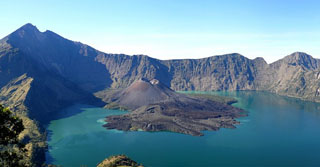Report on Rinjani (Indonesia) — 4 November-10 November 2015
Smithsonian Institution / US Geological Survey
Weekly Volcanic Activity Report, 4 November-10 November 2015
Managing Editor: Sally Sennert.
Please cite this report as:
Global Volcanism Program, 2015. Report on Rinjani (Indonesia) (Sennert, S, ed.). Weekly Volcanic Activity Report, 4 November-10 November 2015. Smithsonian Institution and US Geological Survey.
Rinjani
Indonesia
8.42°S, 116.47°E; summit elev. 3726 m
All times are local (unless otherwise noted)
PVMBG reported that after an eruption occurred at Rinjani on 25 October tremor amplitude increased, and was continuous from 1109 on 2 November through 0600 on 5 November. During 25-31 October dense white emissions rose 900 m above Barujari Crater. During 1-5 November dense gray-to-brown ash plumes rose as high as 1.6 km above the crater. The webcam showed incandescent material being ejected from the crater on 4 November. The Alert Level remained at 2 (on a scale of 1-4); visitors and residents were warned not to approach the crater within a 3-km radius. Based on a 9-November PVMBG notice, BNPB reported that a lava flow had traveled 1 km E of the crater, towards the Koko Putih River. Incandescent material was ejected 750 m above the crater and ash plumes rose 2.5 km. Based on satellite observations and pilot observations, the Darwin VAAC reported that during 4-10 November ash plumes rose to altitudes of 4.3-6.1 km (14,000-20,000 ft) a.s.l. and drifted as far as 740 km NW, W, SW, and S.
According to news articles, Ngurah Rai International Airport in Bali reopened on 9 November but some international flights had remained canceled; the airport had closed the evening before. The closure of Lombok International Airport had been extended until 10 November.
Geological Summary. Rinjani volcano on the island of Lombok rises to 3726 m, second in height among Indonesian volcanoes only to Sumatra's Kerinci volcano. Rinjani has a steep-sided conical profile when viewed from the east, but the west side of the compound volcano is truncated by the 6 x 8.5 km, oval-shaped Segara Anak (Samalas) caldera. The caldera formed during one of the largest Holocene eruptions globally in 1257 CE, which truncated Samalas stratovolcano. The western half of the caldera contains a 230-m-deep lake whose crescentic form results from growth of the post-caldera cone Barujari at the east end of the caldera. Historical eruptions dating back to 1847 have been restricted to Barujari cone and consist of moderate explosive activity and occasional lava flows that have entered Segara Anak lake.
Sources: Pusat Vulkanologi dan Mitigasi Bencana Geologi (PVMBG, also known as CVGHM), Darwin Volcanic Ash Advisory Centre (VAAC), The Jakarta Post, The Jakarta Post

